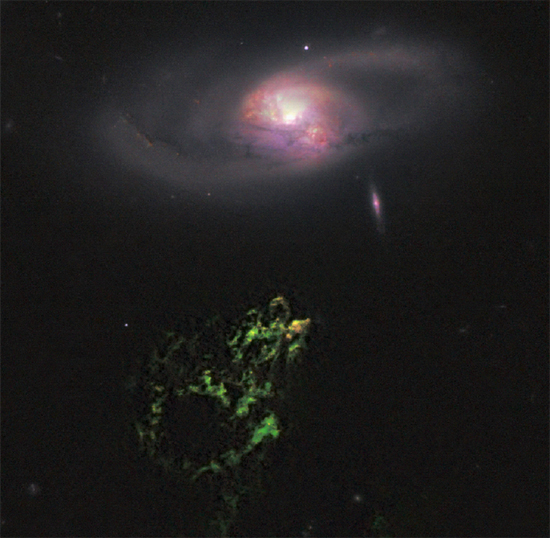|

Galaxy IC 2497 and the ionized
streamer called Hanny's Voorwerp.
Original image credit:
NASA, ESA, William Keel (University
of Alabama, Tuscaloosa), and the
Galaxy Zoo team.
Hanny’s Voorwerp
Feb
11, 2011
Astronomers are puzzled by
this cloud's highly ionized state.
In 2007 Dutch Galaxy Zoo
volunteer, Hanny van Arkel,
discovered the gaseous formation
that bears her name. The strange
thing about it is its excessive heat
and ionization. Some of its spectral
lines indicate the presence of neon
V. It requires 97 electron volts of
energy to strip the electrons from
neon, corresponding to about one
million Kelvin.
A recent
press release points to
suggestions that only a quasar in
the heart of nearby galaxy IC 2497
could generate the energy necessary
to ionize neon, but no quasar can be
seen there. Electric Universe
proponents would like to see the
electrical properties of plasma
added to theoretical formulae rather
than read about each new remote
observation possessing
"extraordinary properties" or
providing "puzzling results" or
revealing "mysterious events."
The filamentary nature of the
Voorwerp is a clue to its
electrically charged nature.
Observations by the Subaru Space
Telescope of galaxy NGC 4388 also
uncovered ionized filaments
extending 110,000 light years from
its nucleus. It was previously
thought that the hypothetical black
hole in the galaxy's center could
only ionize gas out to 50,000 light
years, so the data is baffling to
astrophysicists.
Another vast cloud of hydrogen
gas known as Smith's Cloud, massive
enough to be considered a galaxy
itself, is also glowing in the light
of ionized atoms but there are no
stars there. One more example is
VIRGOHI 21. It does not
shine in visible light but hydrogen
gas glows in radio waves, so its
existence was revealed from a chance
scan by the Arecibo Observatory.
What is the common theme binding all
these observations together?
Electricity flowing through plasma.
Charged particles in motion
constitute an electric current which
take the form of plasma filaments.
An electric current is accompanied
by a magnetic field that wraps
around the current filament,
diminishing directly with the
distance from it.
An electric current filament in
plasma may create a double layer
along its axis. Positive charge
builds up on one side and negative
charge on the other side of the
double layer. A strong e-field
exists between the two charge layers
and if enough current is applied the
double layer will glow, but it is
otherwise detectable only by its
emission of radio noise. Double
layers and current filaments form in
the circuit that threads through the
galaxy. They are mostly invisible
because of their low current
density, but the magnetic fields
they produce can be mapped by radio
telescopes.
A lamp that emits light only at
the excitation frequency of a
specific gas is a more correct model
for Hanny's Voorwerp. Electricity
passing through neon gas causes it
to form a plasma and to glow pale
red. Other gases, such as oxygen,
produce blue light, while heavier
elements emit their own colors.
The helical filaments of the
Voorwerp show that electricity,
traveling along cosmic Birkeland
currents, is energizing the cloud.
The divergence between the Electric
Universe model and the standard
model is based on plasma, which
comprises 99% of the Universe.
Plasma tends to obey the laws of
electromagnetism, so gravity and
kinetic interactions are subsidiary.
Stephen Smith
Hat tip to Jim Johnson
Multimedia

The Lightning-Scarred Planet Mars
Symbols of an Alien Sky
DVD episode 2
A video documentary that could change everything you thought you knew
about ancient times and symbols.
The Symbols of an Alien Sky video series will introduce you to celestial
spectacles and earth-shaking events once remembered around the world.
Archaic symbols of these events still surround us, some as icons of the
world’s great religions, though the origins of the symbols appear to be
lost in
obscurity.
In this second episode of Symbols of an Alien Sky, David
Talbott takes the viewer on an odyssey across the surface of Mars.
Exploring feature after feature of the planet, he finds that only
electric arcs could produce the observed patterns. The high resolution
images reveal massive channels and gouges, great mounds, and crater
chains, none finding an explanation in traditional geology, but all
matching the scars from electric discharge experiments in the
laboratory.
(Approximately 85 minutes) See:
Lightning-Scarred
Planet info
|








